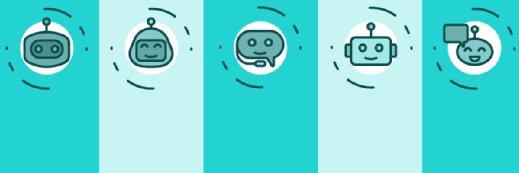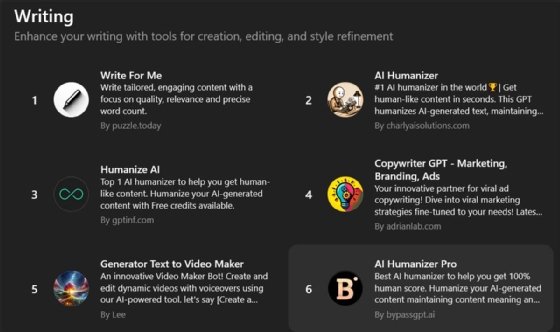
Claude vs. ChatGPT: What's the difference?
Compare Anthropic's Claude vs. OpenAI's ChatGPT in terms of features, model options, costs, performance and privacy to decide which generative AI tool better suits your needs.
In an increasingly crowded generative AI market, two early front runners have emerged: Claude and ChatGPT. Developed by Anthropic and OpenAI, respectively, both products use some of the most powerful LLMs currently available, but the two have some key differences.
ChatGPT is likely today's most widely recognizable LLM-based chatbot. Since its launch in late 2022, ChatGPT has attracted both consumer and business interest due to its powerful language abilities, user-friendly interface and broad knowledge base.
Claude, Anthropic's answer to ChatGPT, is a more recent entrant to the AI race, but it's quickly become a competitive contender. Co-founded by former OpenAI executives, Anthropic is known for its prioritization of AI safety, and Claude stands out for its emphasis on reducing risk.
While both Claude and ChatGPT are viable options for many use cases, their features differ and reflect their creators' broader philosophies. To decide which LLM is the best fit for you, compare Claude vs. ChatGPT in terms of model options, technical details, privacy and other features.
TechTarget Editorial compared these products using hands-on testing, analysis of informational materials from OpenAI and Anthropic, user reviews on tech blogs and Reddit, and industry and academic research papers.
Claude AI vs. ChatGPT model options
Claude and ChatGPT are names for chatbot products, not specific LLMs. When interacting with Claude or ChatGPT, users can choose to run different model versions under the hood, whether using a web or mobile app or calling an API.
Claude
Anthropic offers an online version of Claude at Claude.ai, as well as an iOS app and a developer API. In addition to a free edition, the company offers two paid Claude tiers with monthly fees: $20 per person for Pro, aimed at individual subscribers, and $30 per person for Team, for groups of at least five subscribers.
In early March 2024, Anthropic released the Claude 3 model family, the first major update since Claude 2's debut in July 2023. On June 20, 2024, Anthropic released Claude 3.5 Sonnet, an update to the middle-tier Sonnet model; in a blog post, Anthropic said the 3.5 series of Claude models is forthcoming later in 2024. According to Anthropic's benchmark testing, Claude 3.5 Sonnet outperforms Claude 3 Opus, as well as competitor models, like GPT-4o, on a number of benchmarks.
The Claude 3 series includes versions targeting different user needs:
- Claude 3 Opus. Opus, Anthropic's most advanced and costly model, is available to Claude Pro and Team subscribers online and in the iOS app for a $20 monthly fee. It's also available to developers via Anthropic's API at a rate of $15 per million input tokens and $75 per million output tokens.
- Claude 3 Sonnet. Since the June 2024 release of Claude 3.5 Sonnet, Claude 3 Sonnet is available to developers as a legacy model via the Anthropic API at $3 per million input tokens and $15 per million output tokens.
- Claude 3 Haiku. The cheapest model, Haiku, is available to Claude Pro and Team subscribers on Claude.ai and in the iOS app. For developers using Anthropic's API, Haiku costs $0.25 per million input tokens and $1.25 per million output tokens.
Claude 3.5 Sonnet is available for free on Claude.ai and in the iOS app; Claude Pro and Team subscribers have higher rate limits, meaning they can send more messages within a shorter period of time. Through the API, the model costs $3 per million input tokens and $15 per million output tokens.
Claude 3.5 Sonnet has a knowledge cutoff of April 2024, while the models in the 3 series have knowledge cutoffs of August 2023. All Claude 3 models and Claude 3.5 Sonnet have a 200,000-token context window, or about 150,000 English words. According to Anthropic, the models can handle up to 1 million tokens for certain applications, but interested users need to contact Anthropic for details. And, although all models can analyze user-uploaded images and documents, they lack image generation, voice and internet browsing capabilities.
All Claude 3 models and Claude 3.5 Sonnet are also available via the Amazon Bedrock or Google Cloud Vertex AI managed service platforms.
ChatGPT
OpenAI provides a broader array of models than Anthropic, including several versions of its GPT LLM and specialized non-LLM models, such as Dall-E for image generation and Whisper for speech to text. ChatGPT is available online at ChatGPT.com; via the ChatGPT Android, iOS and macOS apps; and through OpenAI's developer API.
For ChatGPT, OpenAI's main model offerings are GPT-4o, GPT-4 and GPT-4o mini:
- GPT-4o. Released in May 2024, GPT-4o is a multimodal model that processes text, images and audio using the same neural network. In addition to its text chatbot capabilities, it can generate images, analyze uploaded files and browse the web. Users can also create custom assistants called GPTs using GPT-4o.
- GPT-4. Before the release of GPT-4o, GPT-4 was OpenAI's most advanced model, and it's still a powerful option. Like GPT-4o, it's capable of generating images and browsing the internet, and until GPT-4o's voice features roll out to all users, it's also the only ChatGPT option capable of voice interaction.
- GPT-4o mini. OpenAI's most recent release, GPT-4o mini, replaces GPT-3.5, the model behind the first iteration of ChatGPT. It's designed to be fast and highly cost-efficient, though it lacks its counterparts' multimodal and internet-browsing capabilities.
All three models have context windows of 128,000 tokens. GPT-4o and GPT-4o mini have knowledge cutoff dates of October 2023, while GPT-4's is December 2023.
ChatGPT users can access GPT-4o and GPT-4o mini for free, while GPT-4 is available only to paid subscribers. Paid users also have higher rate limits when using GPT-4o and GPT-4o mini. Unlike Anthropic, OpenAI doesn't make its models available on Amazon Bedrock or Google Cloud Vertex AI.
OpenAI offers several pricing options for paid plans:
- ChatGPT Plus, targeting individual users at $20 per month.
- ChatGPT Team, for groups of at least two users at $25 per person per month when billed annually.
- ChatGPT Enterprise, for larger businesses with specific needs. Organizations interested in ChatGPT Enterprise need to contact OpenAI's sales team to discuss pricing.
API pricing varies by model, including fine-tuning, embedding and base language models, as well as coding and image models. For more in-depth comparisons, including API options, see TechTarget Editorial's detailed GPT-3.5 vs. GPT-4 and GPT-4o vs. GPT-4 guides.
Architecture and performance
Anthropic and OpenAI remain tight-lipped about their models' specific sizes, architectures and training data. Both Claude and ChatGPT are estimated to have hundreds of billions of parameters. A recent paper from Anthropic suggested that Claude 3 has at least 175 billion, and a report by research firm SemiAnalysis estimated that GPT-4 has more than 1 trillion. Both also use transformer-based architectures, enhanced with techniques such as reinforcement learning from human feedback.
To evaluate and compare models, users often turn to benchmark scores and LLM leaderboards, which measure AI language models' performance on various tasks designed to test their capabilities. Anthropic, for example, claimed that Claude 3 surpassed GPT-4 on a series of benchmarks and that its Opus model was the first to outperform GPT-4 on the leaderboard Chatbot Arena, which crowdsources user ratings of popular LLMs.
User-generated rankings, such as Chatbot Arena's, tend to be more objective, but benchmark scores self-reported by AI developers should be evaluated with healthy skepticism. Without detailed disclosures about training data, methodologies and evaluation metrics -- which companies rarely, if ever, provide -- it's challenging to verify performance claims. And the lack of full public access to the models and their training data makes independently validating and reproducing benchmark results nearly impossible.
Especially in a market as competitive as the AI industry, there's always a risk that companies selectively showcase benchmarks that favor their models, while overlooking less impressive results. Direct comparisons are also complicated by the fact that different organizations might evaluate their models using different metrics for factors including effectiveness and efficient resource use.
Ultimately, Claude and ChatGPT are both advanced chatbots that excel at language comprehension and code generation. Most users will likely find both options effective for most tasks -- particularly the most advanced options, 3.5 Sonnet and GPT-4o. But details about models' training data and algorithmic architecture remain largely undisclosed. While this secrecy is understandable given competitive pressures and the potential security risks of exposing too much model information, it also makes it difficult to compare the two directly.
Privacy and security
Anthropic's organizational culture centers on minimizing AI risk and enhancing model safety. The company pioneered the concept of constitutional AI, in which AI systems are trained on a set of foundational principles and rules -- a constitution -- intended to align their actions with human values.
Anthropic doesn't automatically use users' interactions with Claude to retrain the model. Instead, users actively opt in -- note that rating model responses is considered opting in. This could be appealing for businesses looking to use an LLM for workplace tasks, while minimizing exposure of corporate information to third parties.
Claude's responses also tend to be more reserved than ChatGPT's, reflecting Anthropic's safety-centric ethos. Some users found earlier versions of Claude to be overly cautious, declining to engage even with unproblematic prompts, although Anthropic promises that the Claude 3 models "refuse to answer harmless prompts much less often." This abundance of caution could be beneficial or limiting, depending on the context; while it reduces the risk of inappropriate and harmful responses, not fulfilling legitimate requests also limits creativity and frustrates users.
Unlike Anthropic, OpenAI retrains ChatGPT on user interactions by default, but it's possible to opt out. One option is to not save chat history, with the caveat that the inability to refer back to previous conversations can limit the model's usefulness. Users can also submit a privacy request to ask OpenAI to stop training on their data without sacrificing chat history -- OpenAI doesn't exactly make this process transparent or user-friendly, though. Moreover, privacy requests don't sync across devices or browsers, meaning that users must submit separate requests for their phone, laptop and so on.
Similar to Anthropic, OpenAI implements safety measures to prevent ChatGPT from responding to dangerous or offensive prompts, although user reviews suggest that these protocols are comparatively less stringent. OpenAI has also been more open than Anthropic to expanding its models' capabilities and autonomy with features such as plugins and web browsing.
The company also said its most recent model, GPT-4o mini, was designed using a new safety technique called instruction hierarchy, which aims to make the model more resistant to jailbreaking and prompt injection attacks.
Additional capabilities
ChatGPT and Claude each have additional functionalities that could be of interest to different users. ChatGPT offers multimodality, internet access and GPTs, while Anthropic offers the recently introduced Artifacts and Projects.
Multimodality
With GPT-4 and GPT-4o, users can create images within text chats and refine them through natural language dialogues, albeit with varying degrees of success. GPT-4 also supports voice interactions, enabling users to speak directly with the model as they might with other AI voice assistants, and GPT-4 and GPT-4o can search the web to inform their responses.
Claude lacks ChatGPT's extensive multimodal capabilities. Although Claude has sufficient vision capabilities to analyze uploaded files, including images and PDFs, it does not support image generation, voice interaction or web browsing.
Custom GPTs
Another unique ChatGPT feature is GPTs, a no-code way for users to create a customized version of the chatbot for specific tasks, such as summarizing financial documents or explaining biology concepts. Currently, OpenAI offers a selection of GPTs made by OpenAI developers, as well as an app store-like marketplace of user-created GPTs. Although GPTs were formerly available only to paid subscribers, OpenAI released the capability to free users with the launch of GPT-4o.
User ratings of GPTs vary widely, and some GPTs seem primarily designed to funnel users to a company's website and proprietary software. Other GPTs are explicitly designed to bypass plagiarism and AI detection tools -- a practice that seemingly contradicts OpenAI's usage policies, as a TechCrunch analysis highlighted.

While Anthropic doesn't have a direct GPT equivalent, its prompt library has some similarities with the GPT marketplace. Released at roughly the same time as the Claude 3 model series, the prompt library includes a set of "optimized prompts," such as a Python optimizer and a recipe generator, presented in the form of GPT-style persona cards. While Anthropic's prompt library could be a valuable resource for users new to LLMs, it's likely to be less helpful for those with more prompt engineering experience.

Although OpenAI's GPTs and Anthropic's optimized prompts both offer some level of customization, users who want an AI assistant to perform specific tasks on a regular basis might find purpose-built tools more effective. For example, software developers might prefer AI coding tools, such as GitHub Copilot, which offer integrated development environment support. Similarly, for AI-augmented web search, specialized AI search engines, such as Perplexity, could be more efficient than a custom-built GPT.
Artifacts and Projects
Claude Artifacts and Projects are two new features launched in June 2024. Artifacts are designed to help users work more easily with what Anthropic describes as "significant and standalone content," such as large documents, websites and code. The content in the Artifact is displayed in its own window next to the chat interface.
Users can then update the Artifact content through their conversations with Claude and see the changes made in real time. For example, developers can visualize larger portions of their code and get a preview of the front end in the Artifact window. The Artifact can be copied to the user's clipboard or downloaded for use outside of the Claude interface. Artifacts are available to all users for free.
Projects are designed for team collaboration, functioning as centralized locations multiple users can access with shared chat history and knowledge. Users need some form of paid access, like a Claude Pro or Team plan, to try Projects.
Teams using Projects can upload documents for Claude to use as stored knowledge, such as company style guides or codebases. They can also add custom instructions, specifying that Claude should respond in a particular tone or giving contextual information about the industry sector the organization works in.
Editor's note: This article was originally written in March 2024 and was updated by the author in July 2024 to reflect updates since the initial publication date, including new models and product features.
Lev Craig covers AI and machine learning as site editor for TechTarget Editorial's Enterprise AI site. Craig graduated from Harvard University with a bachelor's degree in English and has previously written about enterprise IT, software development and cybersecurity.







